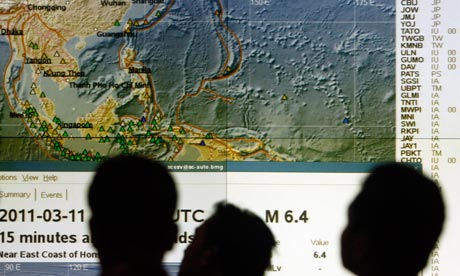Countries across the Pacific from Indonesia to Peru are bracing for the arrival of a series of tsunamis triggered by the largest earthquake in Japan's recorded history, with low-lying Pacific islands at greatest risk.
Dozens of countries are on alert – including the entire west coast of the United States and Canada – as experts warn that the waves could wash right over islands in their path.
Tsunami warnings are in place for countries including the Philippines, Indonesia, Papua New Guinea, Australia, New Zealand, Fiji, Mexico, Guatemala, El Salvador, Costa Rica, Nicaragua, Panama, Honduras, Chile, Ecuador and Columbia.
Authorities are evacuating tens of thousands of people from vulnerable areas.
The largest waves are headed south-west from Japan at about 500mph and could cross the Pacific basin in 24 hours. There have been waves from four to seven metres high crashing into the Japanese coast.
"Our biggest concern is the Asia and Pacific region, where developing countries are far more vulnerable to this type of unfolding disaster. The tsunami is a major threat," said Paul Conneally of the International Federation of Red Cross and Red Crescent Societies.
"At the moment it is higher than some islands and could go right over them," he said.
Several Pacific islands have already been hit by waves of around a metre but larger waves, up to 2m, could reach South America, said Kanoa Koyanagi, a geophysicist at the Pacific Tsunami Warning Centre in Hawaii. The waves are expected to reach Ecuador at 23.31pm GMT, and Colombia and Peru in the early hours of Saturday morning.
"From what we're seeing in some of the Pacific islands most of the wave heights are up to around a metre, but some of those islands aren't in the main beam of the tsunami wave," Koyanagi said.
"There are certain directions the tsunami prefers to go in and those are where you're going to get the biggest waves. Certain parts of the South American coast probably will see almost nothing but other parts might get a metre or two of wave height." The timing between successive waves is around 20 minutes.
The emergency will test the systems put into place to minimise casualties after the devastating Asian tsunami of 2004 in which more than 230,000 people are thought to have died.
Japan warned of possible repeat tsunamis, urging its citizens to stay away from coastal areas. Television showed waves up to 10 metres high in some areas sweeping buildings and vehicles inland.
Deep ocean gauges in the north Pacific had detected waves up to 2m above normal sea level, said Chip McCreary of the Pacific Tsunami Warning Centre.
Sirens sounded in Hawaii where the tsunami is expected to arrive at around 12am GMT. Officials are evacuating all coastal areas.
The island was shaken by a 4.5-magnitude tremor that the US Geological Survey said was probably unrelated to the quake off Japan.
"We're preparing for the worst and we're praying for the best," said John Cummings, spokesman for the Honolulu emergency management department. "Tsunami waves, because of their long length, wrap around our islands very efficiently."
In the Philippines officials ordered an evacuation of coastal communities along the east coast. Disaster management officials in Albay province, south-east of Manila, told residents to gather at designated sites at least five metres above sea level.
Waves were expected to hit Guam, 1,500 miles (2,400km) south of Japan, at 11am GMT. Officials cleared beaches and hotels have moved guests to higher floors.
Taiwan's coastguard began evacuating its east coast, although it is not heavily populated. The waves there are expected to be 50cm to 1m high.
Russian officials have moved 11,000 residents from coastal areas of remote eastern Sakhalin island and nearby territories.
"A tsunami is a series of waves and the first wave may not be the largest," said a bulletin from the Pacific Tsunami Warning Centre.
"The threat can continue for many hours as multiple waves arrive."
The waves will reach Guangdong and Fujian on the east coast of China at around 12.30pm GMT but experts do not expect significant damage.












